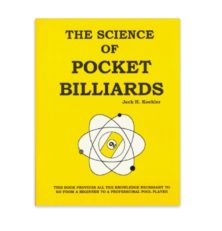The Science Of Pocket Billiards [by Jack H. Koehler]
At at the bottom of the book’s cover, the sub-title says it all: “This book provides all the knowledge necessary to go from a beginner to a professional pool player.” Having read this book, I can say overall that this is a true statement. The Science Of Pocket Billiards is jam-packed with information, covering almost every aspect of billiard play. Some topics are covered in greater depth than others, but there’s not much about the game, and game play, that this book doesn’t have something to say about. For the true student of the game of pool, this book is pure gold. Every page contains insights into the game that can take a lifetime to figure out just by experience alone.
The writing, and the organization of information in the book, is encyclopedic in form. Since the book covers so much ground, trying to read it cover to cover in one sitting is not recommended. This would be like eating an eight-course meal in fifteen minutes – rather than satisfying your appetite, you might experience a negative reaction from it. To truly get the most value from this book, each topic of each chapter needs to be read through – sometimes more than once – and then the knowledge you gain from the reading must be immediately applied. The word ‘science’ is in the title of the book for a reason: like taking a chemistry class, the knowledge comes alive from going back and forth between reading and direct experimentation on the table.
It should come as no surprise that there is a good deal of physics theory involved in the game of pool. Most players prefer to develop an intuitive sense of billiard physics as they play, few have much of an interest in knowing the specifics of billiard ball, table, cushion and cue tip physics. This book covers all aspects of the physics of billiards, in fairly technical terms, accompanied by numerous diagrams and tables. To his credit, the author employs a clear and comprehensible writing style in his explanations. If you ever wondered why certain shots in your arsenal work and why others do not, this book will show you why in a clear and straightforward manner.
In my opinion, there are two main ways to approach this book in order to get the most out of it:
- For beginners and intermediate players, it’s best to start at the beginning, read up to the point where some of the information feels new to you, and then stop. Go to a pool hall and experiment with what you just read. Bring the book with you so you can refer to a fine point in the text while you’re experimenting. But be careful not to bite off more than you can chew, otherwise you run the risk of being overwhelmed. Take things a step at a time, and gear your practice to the text as you go along. Jumping ahead to new topics with which you are not familiar will not help your game.
- For the experienced and advanced players, it’s best to think of the book primarily as a reference. Reading chapters covering everything you know may be helpful, but not necessary if you already have a handle on things. But for areas of your game you know are a problem, chapters covering those areas can be read separate from the rest of the book. If you find, for example, that your play is weak when it comes to rail shots, turn directly to the chapter on rail shots. If you have difficulty banking consistently, turn directly to the chapter on banking (eight – yes, eight – different banking systems are covered in the chapter). Read through the chapter, and then go out and put the knowledge into practice on the table. Be sure to bring the book with you, and go back and forth between the book and the table as you practice. Simply reading about a topic of interest in the book may not help you all that much, in that the level of detail covered in the book is not easy to retain separate from actual experience at the table.
Although the author intends the book to be of interest to 8-ball and 9-ball players, the majority of the information in the book applies to billiards in general and is not slanted toward a specific game. The only chapter where you will find separate discussions of 8-ball and 9-ball is the chapter on game strategies.
This book is an excellent choice for anyone wishing to gain a thorough understanding of billiard physics and play.

